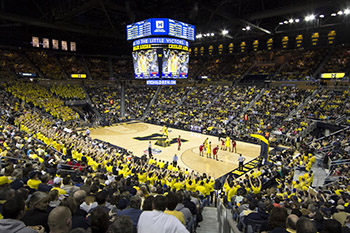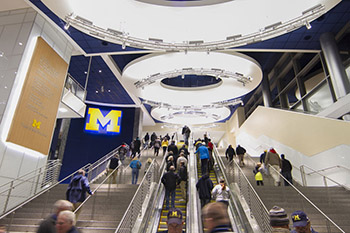 BLOOMFIELD HILLS, Mich. — The University of Michigan’s Crisler Center achieved LEED Gold certification on June 3, 2013. The arena, originally built in 1966, was expanded and renovated in order to more effectively promote and accommodate the University of Michigan’s various athletic programs. Basketball games and practices have been held at the center for more than 50 years, and the facility hosts special events and graduations ceremonies as well.
BLOOMFIELD HILLS, Mich. — The University of Michigan’s Crisler Center achieved LEED Gold certification on June 3, 2013. The arena, originally built in 1966, was expanded and renovated in order to more effectively promote and accommodate the University of Michigan’s various athletic programs. Basketball games and practices have been held at the center for more than 50 years, and the facility hosts special events and graduations ceremonies as well.
Local TMP Architecture Inc. was the architect of record on the project, while Denver-based Sink Combs Dethlefs served as the associate architect and sports consultant for the renovation and expansion. The renovation’s general contractor was Lansing, Mich.-based Clark Construction Company, and the general contractor for the expansion project was Spence Brothers Construction, based in Ann Arbor, Mich.
Renovations on the Crisler Center began in January 2011, with active construction work beginning in April of that year. The renovations were completed in August 2011. Construction work on the expansion project began the following December and was finished in January 2013.
The project was completed in two phases. In the first phase, new seating, HVAC, finishes, lighting replacements and video scoreboard installations were completed. The second phase entailed expanding the concourse to the east, relocating restrooms and concessions, adding an outdoor plaza and constructing a new front door with an escalator and stairway.
A total of 66,720 square feet of space was added to the arena through expansion, with an additional 180,250 square feet retrofitted from the renovation and infrastructure upgrades. The project cost $75 million, with $23 million for renovations and $52 million for an expansion, according to Julie Blue, AIA, LEED AP, project architect/LEED coordinator and associate at TMP Architecture Inc.
Although Blue stated that the condensed time period of 12 months rather than the typical 24 posed a significant challenge, the collaboration between the arena’s owner and the design and construction teams was a major factor that contributed to the project’s success. One aspect of the project that Blue is particularly proud of is the expanded concourse. “The transformation of the concourse area introduced natural light to brighten the space, creating an open feel for users,” she said. “The expanded and renovated space fosters excitement for the Michigan experience.”
Numerous aspects of the newly finished Crisler Center factored into its achievement of LEED Gold certification. Blue said, “The project utilized a high performance envelope addressing moisture infiltration, insulation and daylighting. Low-e coatings on all glazing as well as added insulation and strategically placed overhangs aid in the energy performance of the building. Low-flow plumbing fixtures, attention to indoor air quality and the use of high recycled content and regional materials earned additional points.”
 By renovating and expanding the existing 1966 facility rather than constructing a brand new one, the University of Michigan was able to foster closer relationships between the campus and community, create more public transportation access, maintain at least 50 percent of the original interior and reuse materials from the original walls, floor and roof.
By renovating and expanding the existing 1966 facility rather than constructing a brand new one, the University of Michigan was able to foster closer relationships between the campus and community, create more public transportation access, maintain at least 50 percent of the original interior and reuse materials from the original walls, floor and roof.
Old traditions were kept alive by maintaining much of the preexisting site as well. “The original court flooring was salvaged during the project and utilized in particular design elements of the newly constructed expansion, and in fitting fashion as a backdrop to a display honoring Cazzie Russell,” Blue said.
Cazzie Russell was the star of the men’s basketball team in 1966. The original arena was referred to as “The House that Cazzie Built” in honor of the star’s success.
The Crisler Center’s success also reinforces the University of Michigan’s “planet blue” motto and sustainability goals. “The University has been very progressive in how they approach construction projects in regards to LEED and has implemented several University-wide initiatives that complement the LEED rating system. These initiatives require projects to incorporate particular sustainable features which directly garner LEED points,” Blue said.
The positive outcome of this project paves the pathway for future green building projects at the University of Michigan.

